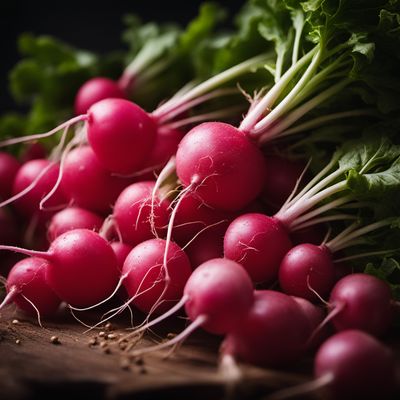
Ingredient
Radishes and similar-
"The Crisp and Colorful World of Root Vegetables"
Radishes and similar root vegetables, such as turnips and beets, are characterized by their firm texture, crisp bite, and earthy flavors. Radishes come in a range of colors, from vibrant red to white, and can vary in size and shape. They have a peppery taste, while turnips offer a milder, slightly sweet flavor. Beets, on the other hand, have a distinct earthy and slightly sweet taste. These vegetables are often enjoyed raw in salads for their refreshing crunch, but they can also be cooked to soften their texture and enhance their flavors.
Origins and history
Radishes have a long history and are believed to have originated in Southeast Asia. They were cultivated in ancient Egypt and Greece, where they were highly valued for their medicinal properties. Turnips have been cultivated for thousands of years and were a staple in ancient Roman and Greek diets. Beets have a rich history as well, with evidence of their cultivation dating back to ancient civilizations in the Mediterranean region. These root vegetables have played significant roles in various cultures and cuisines throughout history.
Nutritional information
Radishes and similar root vegetables are low in calories and high in fiber, making them a nutritious addition to any diet. They are also rich in vitamins C and K, as well as minerals like potassium and manganese.
Allergens
There are no known allergens associated with radishes and similar root vegetables.
How to select
When selecting radishes and similar root vegetables, look for firm and plump specimens with smooth skin. Avoid any that are soft, shriveled, or have blemishes. For turnips and beets, choose those with vibrant colors and crisp greens, if attached.
Storage recommendations
To maintain freshness, store radishes and similar root vegetables in the refrigerator. Remove the greens from turnips and beets before storing, as they can draw moisture from the roots. Place them in a perforated plastic bag or wrap them in a damp paper towel to prevent them from drying out.
How to produce
Radishes and similar root vegetables can be easily grown in home gardens. They thrive in cool weather and require well-drained soil. Sow the seeds directly in the ground or in containers, ensuring they receive adequate sunlight and regular watering. Harvest when the roots have reached the desired size.
Preparation tips
Radishes can be enjoyed raw in salads, sliced and pickled, or roasted to mellow their flavor. Turnips can be boiled, mashed, or roasted, while beets can be roasted, boiled, or grated for salads. For a unique twist, try using radish greens in pesto or sautéing them as a side dish.
Substitutions
If radishes are not available, you can substitute them with jicama or daikon radishes for a similar crisp texture and mild flavor.
Culinary uses
Radishes are commonly used in salads, sandwiches, and as a garnish for their refreshing crunch and peppery taste. Turnips are often used in stews, soups, and roasted vegetable medleys, while beets are popular in salads, roasted as a side dish, or used in desserts like beet cake.
Availability
Radishes and similar root vegetables are commonly available in most regions and can be found in grocery stores, supermarkets, and farmers markets.



